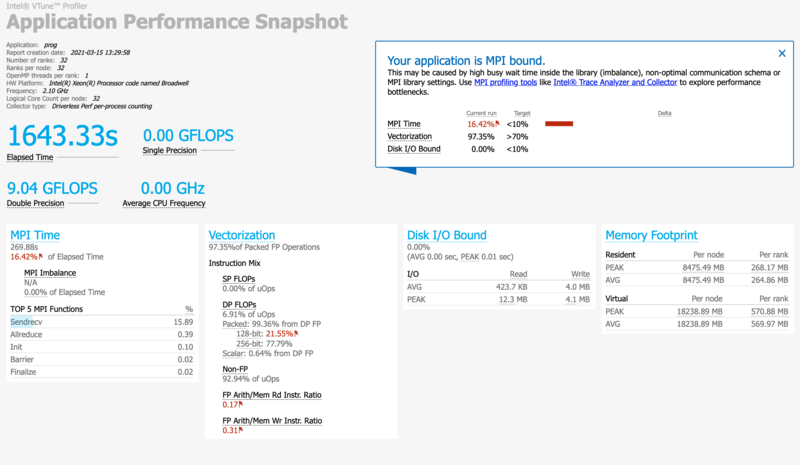Vtune: Difference between revisions
(add MPI section) |
m (→MPI example) |
||
| Line 81: | Line 81: | ||
== MPI example == | == MPI example == | ||
First, load the latest | First, load the latest VTune module. | ||
module load StdEnv/2020 | module load StdEnv/2020 | ||
| Line 92: | Line 92: | ||
After the program finishes, the profiling data will be stored in a directory called aps_result_YYYYMMDD where YYYYMMDD is the current date. | After the program finishes, the profiling data will be stored in a directory called aps_result_YYYYMMDD where YYYYMMDD is the current date. | ||
There is a lot of information you can extract from that data. To get the basic summary report of your | There is a lot of information you can extract from that data. To get the basic summary report of your program's performance, run: | ||
aps-report -D aps_result_YYYYMMDD | aps-report -D aps_result_YYYYMMDD | ||
| Line 98: | Line 98: | ||
where you would replace YYYYMMDD to match the actual directory that has been created. This command creates an HTML file, which can be copied to your own computer and viewed in a browser. The report will clearly identify performance issues that are affecting your code. | where you would replace YYYYMMDD to match the actual directory that has been created. This command creates an HTML file, which can be copied to your own computer and viewed in a browser. The report will clearly identify performance issues that are affecting your code. | ||
[[File:Vtune mpi profiling report.png|thumb|800px|Example report generated by aps for an MPI program]] | [[File:Vtune mpi profiling report.png|thumb|center|800px|Example report generated by aps for an MPI program]] | ||
Revision as of 17:21, 16 March 2021
Introduction[edit]
VTune is Intel's Performance Analysis tool for applications and systems. It is capable of Analyzing both OpenMP and MPI based applications.
Software Module[edit]
To load the module on any Compute Canada cluster run:
[name@server ~]$ module load vtune
Tool Re-Naming[edit]
The content of this wiki is mostly discussed in terms of the legacy named Intel® VTune™ Amplifier. Please note the tool has been renamed throughout Intels documentation in latest versions (newer than the latest vtune module versions presently available on Compute Canada systems) from Intel® VTune™ Amplifier too Intel® VTune™ Profiler. Likewise the application commands amplxe-cl and amplxe-gui have been renamed too vtune and vtune-gui for both the command line and gui tools respectively. Once a version with the newer naming convention is available as a loadable module in the forthcoming default StdEnv/2020 environment this wiki page will be updated accordingly. Further information can be found here.
Collect Analysis[edit]
To collect analysis information run:
[name@server ~]$ amplxe-cl -collect <analysis-type> <target_exe> <exe_arguments>
where <analysis-type> should be replaced by one of the available analysis, e.g. hotspots, and <target_exe> is the path to the executable you would like to analyze. It is recommended to compile your executable with the "-g" option and to use the same optimization level as normal so as to obtain accurate results. A listing of version specific argument options and several usage examples maybe displayed on the command line by running amplxe-cl -help, after loading the vtune module. Complete downloadable documentation for Parallel Studio XE (including VTune) for all recent versions can be found here. The latest version of the Intel VTune Profiler User Guide may be found here.
Create Report[edit]
To create a report run this command:
[name@server ~]$ amplxe-cl -report <report-type>
where <report-type> is the type of the report to generate, e.g. hotspots. See also:
Matrix Example[edit]
Analyze and generate a summary report for the Intel Matrix Sample Project run from the command line with 4 cores:
salloc --time=1:00:00 --cpus-per-task=4 --ntasks=1 --mem=16G --account=def-yours module load StdEnv/2016.4 *OR* StdEnv/2018.3 module load intel/2019.3 (optional) module load vtune/2019.3 cp -a $EBROOTVTUNE/vtune_amplifier/samples/en/C++/matrix . cd matrix/linux make icc amplxe-cl -collect hotspots ../matrix amplxe-cl -report summary
The latest version of matrix_multiply (uses cmake to build) can be found here.
Graphical Use[edit]
The Intel Matrix Sample Project an also be run using Vtune in GUI mode as explored here [1]. To run VTune over VNC follow the below directions depending on which system you wish to use. Running VTune graphically can be useful to generate command line configurations as discussed in [2].
Cluster Nodes[edit]
- Connect to a cluster compute or login node with TigerVNC
module load StdEnv/2016.4 *OR* StdEnv/2018.3module load intel/2019.3(optional)module load vtune/2019.3amplxe-gui
VDI Nodes[edit]
- Connect to gra-vdi.computecanada.ca with TigerVNC
module load CcEnv StdEnv/2016.4 *OR* StdEnv/2018.3module load intel/2019.3(optional)module load vtune/2019.3amplxe-gui
MPI example[edit]
First, load the latest VTune module.
module load StdEnv/2020 module load vtune
Then compile your MPI program as you usually would and run it inside a job or in an interactive session started by a salloc command using:
srun aps your_mpi_program.x
After the program finishes, the profiling data will be stored in a directory called aps_result_YYYYMMDD where YYYYMMDD is the current date.
There is a lot of information you can extract from that data. To get the basic summary report of your program's performance, run:
aps-report -D aps_result_YYYYMMDD
where you would replace YYYYMMDD to match the actual directory that has been created. This command creates an HTML file, which can be copied to your own computer and viewed in a browser. The report will clearly identify performance issues that are affecting your code.
